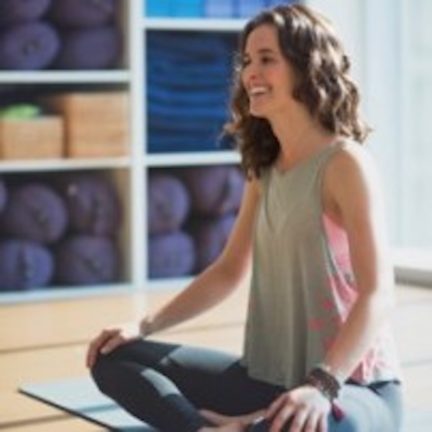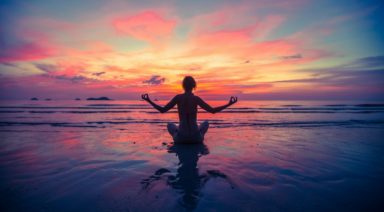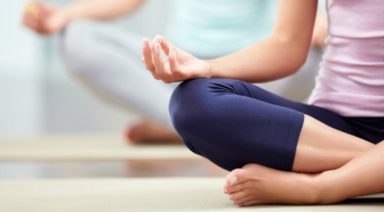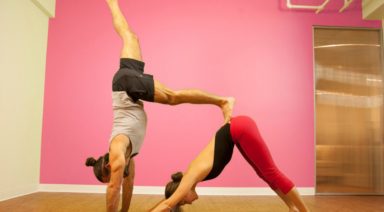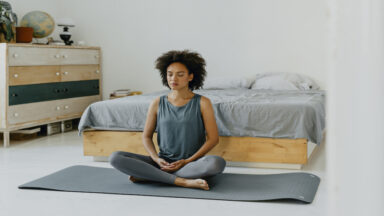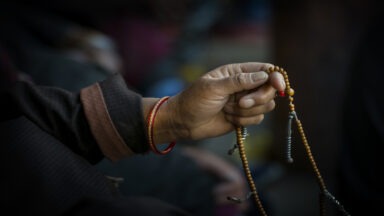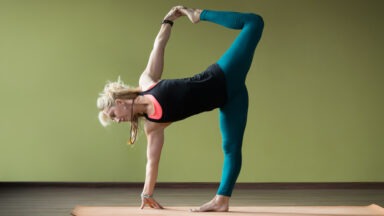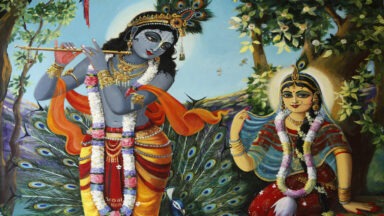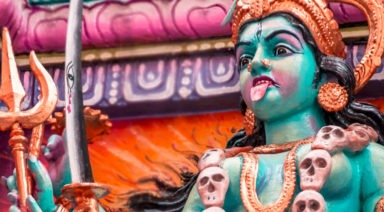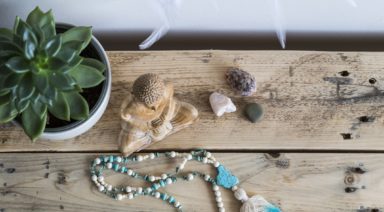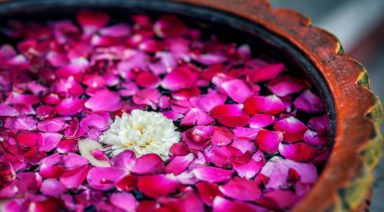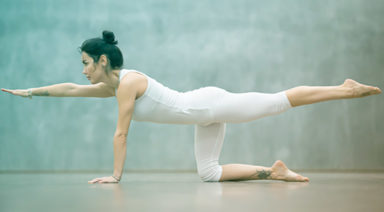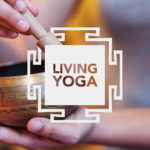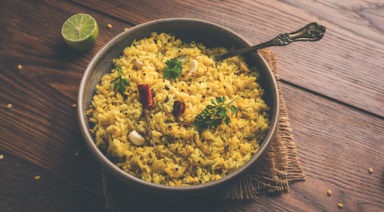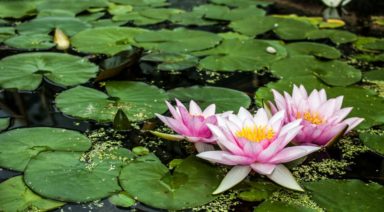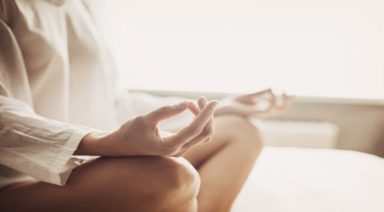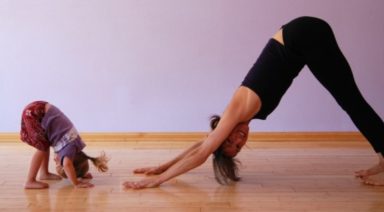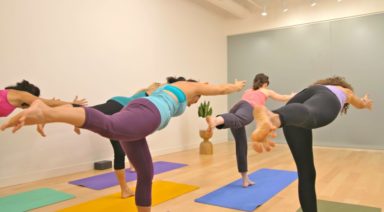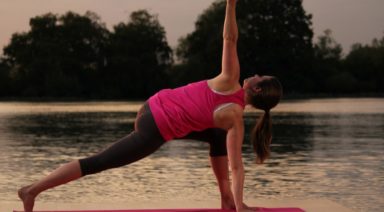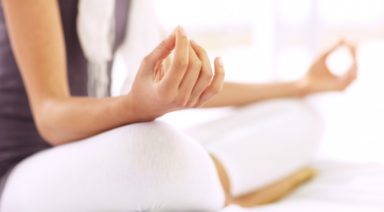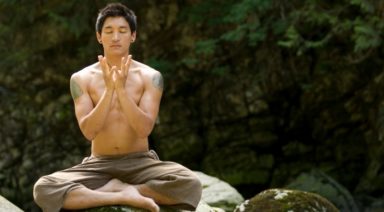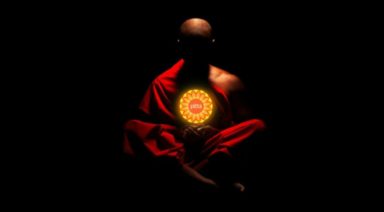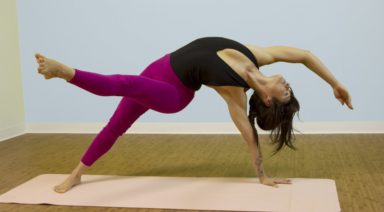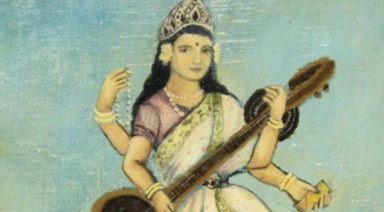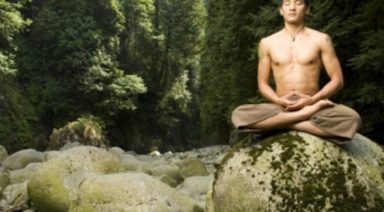Yoga Mala
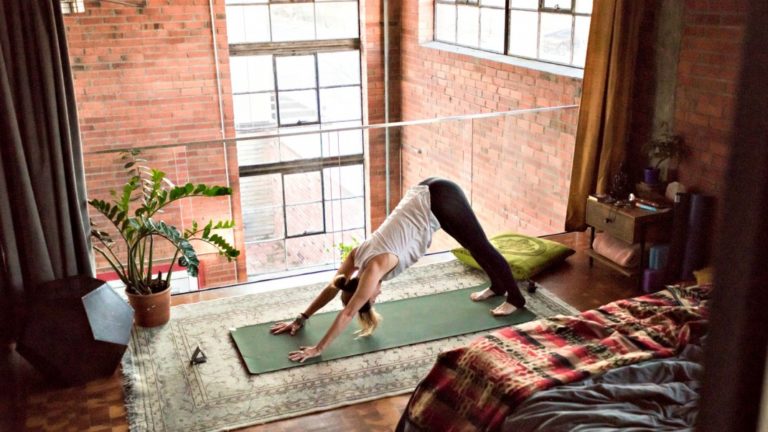
A mala, meaning garland in Sanskrit, evokes a circular, continuous form. In practice, a mala is the devoted offering of repeated cycles (typically in divisors of 108) of mantra Japa or yoga asana. Within a mala, there is always a sense of beginning, continuing, and completion. Both inside each individual cycle and in the practice as a whole. This three-form (trimurti) quality allows us to embody, in practice, the rhythmic cycles ever-present in the natural universe: creation (srishti), sustaining (sthiti) and destruction (samhara).
During a yoga mala, the types of offerings include mantra japa, pranam and yoga.
Offering: Mantra Japa
Chanting mantra, either internally or aloud, has a vibrational impact on the body and mind. A mantra, meaning a tool or skill of thought, imbues the practice of yoga with a primordial rhythm and when offered continuously (japa), mantras are designed to liberate consciousness.
“Mantras are the sounds that should accompany our yoga postures. Like strands of DNA, these sounds offer yoga practitioners a direct link to the source and substance of the yoga tradition. Just as you cannot truly grasp science without knowing its language—mathematics— it is impossible to touch upon the depth of yoga without knowledge of mantras.” ::Russill Paul, The Yoga of Sound
When preparing to practice mantra Japa, select a mantra that resonates with what you want to cultivate through your offering. Included below are several mantras that serve different purposes in practice. They are short, potent and readily learned through repetition. While an English mantra may be just as powerful, the Sanksrit mantras are intelligently crafted to awaken your whole being with vibration, not just the mind.
| MANTRA | MEANING | INTENTION |
|---|---|---|
| oṁ namaḥ shivāya | I bow to the inner Self who is one with the source of all creation | union |
| oṁ hrim hamsa soham svaha | I bow to the supreme light, to emerge from darkness | purification |
| oṁ maṇi padme hūṃ | May the jewel in the lotus shine forth the light and love of compassion to unite all as one. | compassion |
| oṃ guṃ gaṇapataye namaha | I bow to Ganapati the benevolent remover of obstacles. | overcoming obstacles |
| lokāh samastāh sukhino bhavantu | May all beings everywhere be happy and free. | metta, lovingkindness |
Offering: Pranam
For a gentle, yet transformative practice, you may choose to offer pranams (prostrations) in lieu of the traditional namaskaras (salutations) outlined below. The practice of prostration or kneeling is common to many spiritual traditions and the physical gesture of bowing is understood universally as conveying respect, honor, and reverence.
A pranam is the simple surrender of the whole body to the earth in a prone position.
Begin standing, then lower the hands to the ground and slowly walk them away from the feet to place the belly on the floor. Rest the forehead on the hands like a pillow and stay here for at least one cycle of breath. To complete the pranam, in your own way, press the body up off the floor and return to standing. Use the breath to initiate each movement and move slowly. With relatively uncomplicated form, a mala of pranams may be completed with the eyes closed to facilitate deeper focus and meditation.
Offering: Yoga
A yoga mala can be completed using any combination of practices that totals 108, or for a shortened practice, 27, 54, etc. My favorite way to practice a yoga mala is by completing 12 total cycles, each consisting of 7 surya namaskar A and 2 surya namaskar B, 12 x 9 = 108. Typically, postures for traditional sequences.
Modifications
In this style of yoga mala, there are potentially more than 200 forward bends and more than 150 “push-ups”; For even the most seasoned yoga practitioner, this is a lot to ask of the body. Listed below are common modifications to the traditional form to encourage a sustainable practice that leaves you feeling nourished, not depleted. You may decide to modify every round or alternate between full and modified expressions as is appropriate.
Upper Body
- Bend the elbows for any postures where the arms are extended overhead. This is a great option for anyone with shoulder sensitivity or as the arms begin to fatigue. This can also alleviate dizziness and is recommended for anyone with hypertension
- Skip the basic vinyasa (chaturanga and upward facing dog) and step straight back to downward facing dog from forward bending. Enjoy a few extra moments to catch your breath in downward dog or rest in child’s pose instead
- Substitute cobra or locust pose for upward dog. These postures extend the spine in the same way with little to no weight bearing on the hands
- Substitute forearm plank and dolphin for plank and downward dog for sensitive wrists. When taking this modification, it is recommended to transition slowly from hands to forearms with the knees lowered
- Substitute puppy pose or child’s pose for downward dog, placing less weight on the hands
Lower Body
- Bend the knees in forward bends. This is recommended for all practitioners, even those with an advanced forward bending practice who can very easily touch the ground with straight legs. A gentle bend in the knees will help recruit the larger muscles of the legs for support, especially when the body becomes fatigued, instead of defaulting to the knees and lower back. Similarly, maintain a gentle bend in the knees as you transition from forward bending to standing
- Substitute high or low lunge for warrior one. Lowering the back heel in this split-leg posture requires significant mobility in the hips and legs, enjoy these lunge modifications for several rounds in the beginning until the body is sufficiently warm or as alternatives to warrior one when the legs become tired
Transitions
- With a fluid and repetitive rhythm, it can be easy to hurry from one pose to the next. A mala can be practiced with one breath per movement, but enjoy additional breaths as needed and do not rush through the process. It is far better to complete 54 rounds safely and with self-compassion than to suffer through 108 for the sake of the numerical metric
Your Practice is Personal
The practice of a yoga mala can be deeply cleansing and invigorating, especially when completed during a seasonal shift such as a solstice or equinox. This practice is also welcomed during any time of personal transition or universal celebration. The new year, for instance, is a potent time of creation as we chart a path for the year to come. Through the dedication of a yoga mala, we can dissolve what has passed and galvanize our intentions for the year ahead.
A Moving Meditation
A yoga mala is the ultimate moving meditation with a repetitive, steady rhythm that helps transcend the purely physical form and move us closer to the unified Self. One body, one mind, one breath. Each forward bend serves as a pranam to the source and each vibrant backbend is an emergence of radiant light. The body is the mala, the breath is the mantra.
My dear friend and yoga teacher once told me that praying is when you ask the big questions whereas meditation is when you listen for the big answers. A yoga mala offers us practice for sweating our prayers in movement so that we might listen for what arises in meditation.
What is the Significance of 108?
The number 108 has a range of significance across many different cultures and disciplines. For example, this number informs the architecture of sacred texts that are central to yoga and eastern philosophy. As a devoted scholar of yoga and tantra, my teacher Shiva Rea explains in Tending the Heart Fire, “there are 108 chapters of the Rig Veda, 108 Upanishads, and 108 primary Tantras.” And these texts are written in Sanskrit, a language comprising 54 letters, each with a masculine (Shiva) and feminine (Shakti) form, 54 x 2 = 108. Additionally, listed below are just a few of the many relationships that carry this number.
- In in the field of Ayurveda, there are 108 sacred places, or marmas, in the body, identifying intersections of matter and consciousness. When manipulated, these points can awaken and align the vital energy
- Members of the Vedic tradition see this number as denoting the wholeness of the universe: one represents the solar masculine, zero represents the lunar feminine and eight represents the infinite nature of all things
- In the classic japa mala, used in Buddhism and Hinduism, there are 108 beads used for prayer and mantra
- Mathematicians favor the number 108 for its countless patterns and potential divisions. For example, it is divisible by the sum of its parts and most of its proper divisors, making it a semiperfect number
- Through the lens of astronomy, the diameter of the sun is approximately 108 times that of earth and the distance from our planet to its solar star is, on average, 108 times the diameter of the sun. A similar parallel relationship also exists between the earth and the moon
The unequivocal nature of numbers, unlike language, is absolute. However, it is the way in which we relate to and extract meaning from numbers that brings them to life. Be it randomized coincidence or divine order, there is something undeniably special about one hundred and eight.
How to Keep Count
A mala uses repetition to break free from the fluctuations of the mind, so it may seem counterintuitive to introduce any method of keeping count, which can be a predominantly mental exercise. When offering japa mantra, this conundrum is easily solved using of a string of beads or stones. With the completion of each cycle mantra, the beads are delicately transferred through the fingers of the right hand, beginning and ending with the large bindu, or guru bead, for a total of 108 rounds. In a yoga practice, this task compels a little more creativity, but it need not be complex. You might use small pieces of paper, beans or seeds, or even the chakras of the body to count internally.
To practice a mala with the traditional sequences outlined above, you will simply need three different styles of counters and four small containers or piles. When I offer personal practice, I use three different colored beads and four small clay cups. The first cup has seven clear beads, each representing one surya namaskar A and two wooden beads, each representing one surya namaskar B. The second and fourth cups are empty and the third cup has 12 rudraksha beads, each representing a complete round.
When completing a single round, the seven clear beads and two wooden beads are transferred from the first cup to the second cup at the end of each surya namaskar A and B respectively. When the transfer is complete, a single rudraksha bead is transferred from the third cup to the fourth cup. In the next round, seven clear and two wooden beads are returned from the second cup to the first cup, and another rudraksha bead is transferred from the third to the fourth cup. The clear and wooden beads are continuously transferred between the first and second cups until all rudraksha beads are in the fourth cup. It may seem complicated, but give it a shot, it’s easier than you think.
Remember, the completed number of mantras or asanas is not what matters most. You may choose to let go of the numbers altogether and simply practice until your heart feels complete.
What is Tantra Yoga?
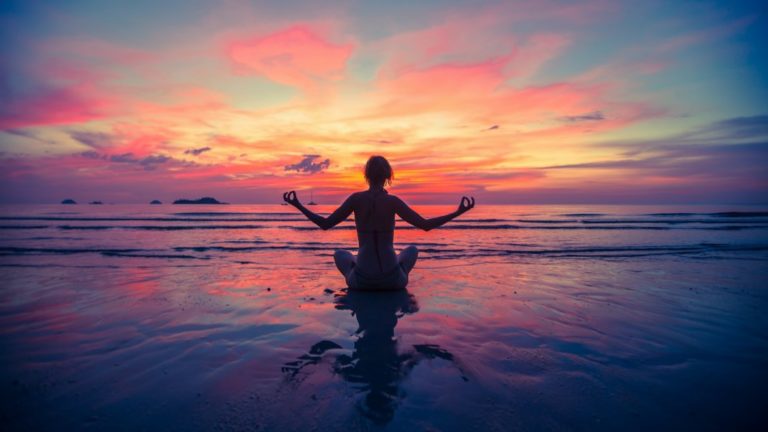
If the word Tantra conjures up scenes of sexuality, you’re not alone. The introduction of Tantric practices in the West has inadvertently become identified with a practice that’s laced with nudity, sexuality, and occasionally, promiscuity.
The truth is, Tantra may enhance your sex life, but only by deepening your connection to your energy and your body first. Although Tantric practices are founded on the principle of intimacy, intimacy is not purely physical. It’s the act of connecting so deeply that you feel as if you are getting a glimpse into your and perhaps another’s soul.
I’ve heard it described as “into me I see” based on the premise that we must gain an awareness of our true selves before we can forge the path of union with others.
What’s the point of Tantra Yoga?
The purpose of Tantra Yoga, is to further emotional wellbeing, aiding spiritual and physical health.
The exploration of the subtle energies within the body and their connection to the universe provide the opportunity to understand the purpose of life and the principles of union in new dimensions.
Rod Stryker, a prominent teacher of Tantra Yoga, describes the intention of Tantra Yoga, “(it) shows us what is blocking us from thriving and offers techniques that will help us attain spiritual and material prosperity.” Hence the goals of the Tantric practices are to enable us to prosper, to thrive and to merge the spiritual world and the material world into one.
What is Tantra Yoga?
The word Tantra means, “to weave or expand.” The root of the word yoga is “yuj” which means, “union.” Similar to some of the other 8 Forms of Yoga, Tantra Yoga blends elements of Raja, Bhakti, Karma, Kundalini, and Hatha practices. What distinguishes it from others is that it also weaves dynamics of other mystical practices as well such as: astrology, Ayurveda, crystals, and gemology to name a few. In utilizing these aspects, the Tantric practice aims to expand beyond perceived limitations of yogic philosophy and the asanas.
The comprehensive approach of Tantra Yoga incorporates conscious breathing practices, pranayama, and meditation, and may be practiced individually or in partnership with another. In both practices, the relationship between the micro (self) and the macro (others) is enhanced.
Vinyasa, as a moving meditation through postures, or asanas, also may be practiced partnering, as a blending of energies or as a sole practitioner. The aim is the same: to gain awareness of our strengths and weaknesses, the places where we resist union with ourselves and others, and cultivate the ability to consciously respond rather than unconsciously react to both our fears and desires. When that occurs, we reach a state of eternal bliss.
Five Tantra Yoga Practices
1. Peace Pose with Pranayam, Conscious Breathing
Begin in a cross-legged seated position, Sukhasana, or peace pose. Gaze down; if knees are higher than hip creases, sit on a yoga block or rolled up yoga mat to elevate the spine.
For solo practice, place hands in gyan mudra (also referred to as jnana mudra in some practices) with the tip of the index finger touching the tip of the thumb, extending out the other three fingers with the palms facing up and resting on knees or thighs. Gyan mudra, a yogic shape for the hands, is considered the prime mudra with many health and grounding benefits.
If practicing with a partner, sit back to back in peace pose, sukhasana. You’ll want to align your spines: start by scooting your seats as close to one another as possible. Option to use prithvi mudra, tips of the ring fingers touching the tips of the thumbs, remaining three fingers outstretched but relaxed. This mudra creates a circuitry igniting the heart meridian, or line of energy that extends from the ring fingers, extends up through the arms and confluences at heart center in both the front and backside of the chest.
Take five full breaths, focusing on smoothing out the length of the inhale to match the same length on the exhale.
2. Sun Salutations, Surya Namaskar
Start in mountain pose (tadasana/urdhva hastasana), standing at the top of your yoga mat. As an individual practice, you may like to practice facing a full-length mirror. In a partner practice, you could either practice facing one another or side by side. Bring palms to meet at heart center in anjali mudra (prayer gesture) or place one hand on your heart, and one on your partner’s heart. Take five deep breaths.
Extend arms overhead, mountain pose, then bow forward, keeping your heart open and gaze forward, and release your head into a forward fold (uttanasana). Bring hands to shins or thighs and lengthen through your spine for a halfway lift (ardha uttanasana). Repeat three times.
3. Modified Side Plank/ Partner Modified Side Plank Pose
Start in table pose, wrists aligned under shoulders, hands spread wide, and hips stacked over knees. For partner modified plank pose, you can lightly touch the crown of the head with one another while in table. Then extend your right shins behind you, toes curled under as you root right hand into the mat and open your chests towards one another.
For an individual practice, bring your left hand to rest over your heart as you stack your left shoulder over right so your heart is wide open. Your hips are also stacked creating a beautiful opening for what are considered our more vulnerable energetic centers: hips and hearts. In partner practice, connect left palms overhead. Enjoy five breaths. Return to table and then switch sides.
4. Partner Peace Pose, Entwined Sukhasana
Come into a loose, cross-legged position (typically the larger person in sukhasana first). Your partner then sits on your thighs and crosses their ankles behind your back. Touch your third eye centers (space between the eyebrows) as you both lengthen through your spines. You may choose to close your eyes or gaze lightly into each other’s eyes as you inhale and exhale through the nose. Take five breaths, allowing a natural synchronicity of breath, with your palms resting on the backside of your partner’s heart. Surrender to the intimate experience of both your and your partner’s heartbeat.
5. Child’s Pose (Balasana), Partner Child’s Pose
Bring your knees wide to the edges of your mat, fold forward resting your forehead on the mat, arms extended overhead but resting on the mat. (If knees are sensitive, you can place the folded edges of a blanket behind your knees before folding forward or rest your seat and perhaps forehead on yoga blocks.) If shoulders allow, bring your palms to touch in prayer, symbolic of union with all aspects of yourself.
For partner child’s pose, assume the same shape described above, with heads pointed towards one another. With arms outstretched, you can place your left palm down, and your palm up to connect with your partner’s palms. It’s said that our hands are an extension of our hearts. Envision your inhale emerging from your left palm, breathing in the essence of your partner, and exhaling through your right palm, sharing your essence with your partner.
For a more advanced practice, presuming both partners have healthy knees and spines, you may like to have one partner (typically the larger partner) stay in child’s pose, and the other, sit facing the opposite direction, on the low back of the partner in child’s pose. Slowly, keeping weight in your feet, begin to lower down, using the support of hands on the mat alongside the bottom partner’s hips. Eventually, lower your spine to align with the partner in child’s pose, and relax arms alongside, or extend your arms overhead, sliding palms underneath your partner’s palms.
Stay in close communication with your partner in child’s pose to ensure that each of the actions feels safe and available in their body.
Expand Your Capacity For Intimacy
If you’re practicing Tantra Yoga on your own or with a partner, you’re expanding your capacity for intimacy and union. With practice, we’re able to get up close and intimate with the beliefs and behaviors that hold us back from the intimacy we desire. In addition, Tantric techniques are provided to evolve beyond these barriers so that each and every one of us may thrive and prosper.

